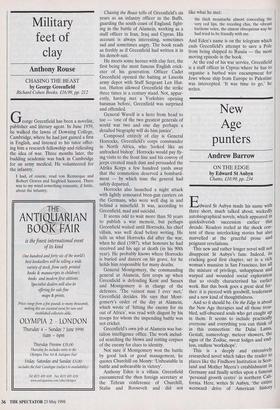Military feet of clay
Anthony Rouse
CHASING THE BEAST by George Greenfield Richard Cohen Books, £16.99, pp. 212 George Greenfield has been a novelist, publisher and literary agent. In June 1939, he walked the lawns of Downing College, Cambridge, where he had just gained a first in English, and listened to his tutor offer- ing him a research fellowship and ridiculing the idea of war. Three months later, the budding academic was back in Cambridge for an army medical. He volunteered for the infantry.
I had, of course, read von Remarque and Robert Graves and Siegfried Sassoon. There was to my mind something romantic, if futile, about the infantry. Chasing the Beast tells of Greenfield's six years as an infantry officer in the Buffs, guarding the south coast of England, fight- ing in the battle of Alamein, working as a staff officer in Iran, Iraq and Cyprus. His account is always interesting, sometimes sad and sometimes angry. The book reads as freshly as if Greenfield had written it in his demob suit.
He meets some heroes with clay feet, the first being the most famous English crick- eter of his generation. Officer Cadet Greenfield opened the batting at Lincoln army depot with Staff Sergeant Len Hut- ton. Hutton allowed Greenfield the strike three times in a century stand. Not, appar- ently, having met a Yorkshire opening batsman before, Greenfield was surprised and offended.
General Wavell is a hero from head to toe — `one of the two greatest generals of world war two and one day perhaps a detailed biography will do him justice'.
Composed entirely of clay is General Horrocks, Greenfield's corps commander in North Africa, who 'looked like an unfrocked bishop'. Horrocks would pay fly- ing visits to the front line and his convoy of jeeps created much dust and persuaded the Afrika Korps a few hundred yards away that the commotion deserved a bombard- ment — by which time the general had safely departed.
Horrocks also launched a night attack with lightly armoured bren-gun carriers on the Germans, who were well dug in and behind a minefield. It was, according to Greenfield, mad and suicidal.
It seems odd to wait more than 50 years to publish a war memoir, but perhaps Greenfield waited until Horrocks, his chief villain, was well dead before writing. He tells us what Horrocks did after the war, when he died (1987), what honours he had received and his age at death (in his 90th year). He probably knows where Horrocks is buried and dances on his grave, for he holds him responsible for many deaths.
General Montgomery, the commanding general at Alamein, first crops up when Greenfield is defending Kent and Sussex and Montgomery is in charge of the defences. 'The vainest man I ever met,' Greenfield decides. He says that Mont- gomery's order of the day at Alamein, which wrote of 'hitting the enemy for six out of Africa', was read with disgust by his troops for whom the impending battle was not cricket.
Greenfield's own job at Alamein was bat- talion intelligence office. The work includ- ed searching the blown and rotting corpses of the enemy for clues to identity.
Not sure if Montgomery won the battle by good luck or good management, he quotes Churchill on Monty: 'Unbeatable in battle and unbearable in victory'.
Anthony Eden is a villain. Greenfield encountered the then foreign secretary at the Tehran conference of Churchill, Stalin and Roosevelt and did not like what he met:
the thick moustache almost concealing the very red lips, the receding chin, the vibrant baritone voice, the almost obsequious way he had tried to be friendly with me.
And Eden's name is on the telegram which ends Greenfield's attempt to save a Pole from being shipped to Russia — the most moving episode in the book.
At the end of his war service, Greenfield is a staff officer in Cyprus where he has to organise a barbed wire encampment for Jews whose ship from Europe to Palestine was intercepted. 'It was time to go,' he writes.


































































 Previous page
Previous page